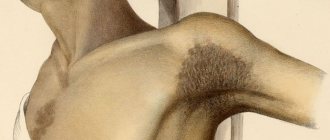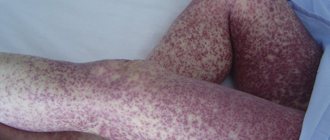Causes
Translated from Greek, glossa is language. Glossitis of the tongue is an inflammation of non-infectious and infectious origin, causing inflammation on the surface of the tongue, or in its deep layers.
Glossitis of the tongue very rarely develops as an independent disease. In most clinical cases, this is a clear manifestation of some inflammatory disease, for example, stomatitis. Therefore, if glossitis bothers you, treatment may be associated with other diseases.
According to statistics, glossitis occurs more often in men, mainly over 40 years of age. However, in the event of burns, injuries to the tongue, or exposure to various harmful chemicals on the tongue, glossitis can develop in a person at any age.
We can identify a group of people who are most at risk of developing this disease:
- smokers;
- people who often eat spicy or too salty foods;
- excessive use of mouth rinses.
Glossitis is a symptom of certain diseases and conditions of the body:
- lack of vitamins (A, E, B12 and folic acid);
- anemia;
- scarlet fever and measles;
- diphtheria;
- diseases of the stomach and intestines;
- helminthic infestations;
- lichen planus;
- allergy;
- stomatitis;
- candidiasis;
- systemic lupus erythematosus;
- taking antibiotics;
- rheumatism, etc.
Causes
There are several factors that can provoke the development of desquamative glossitis. These include:
- mechanical effects on the mucous membrane of the tongue due to fractures and cracks of teeth, operation of dental structures and devices, unprofessionally installed crowns or sharp edges of fillings;
- chemical or thermal burns of the tongue mucosa;
- eruption of teeth (including in the wrong place or direction), as a rule, these are wisdom teeth.
Desquamative glossitis can develop against the background of another disease. This most often occurs with the following ailments:
- chronic diseases of the gastrointestinal tract;
- problems with the liver and gall bladder;
- disorders of the autonomic and endocrine systems;
- rheumatic ailments;
- lack of microelements and vitamins in the body - hypovitaminosis of vitamins B1, B3, B6, lack of pantothenic and folic acids, low iron levels);
- diseases associated with the hematopoietic process;
- autoimmune diseases;
- some types of chronic dermatitis.
The disease can also form with the participation of infectious processes occurring in the body, such as scarlet fever, helminthic infestation, viral infections, and influenza. Intoxication due to the use of potent antibiotics can also provoke desquamative glossitis and stomatitis. For details regarding the treatment of stomatitis after antibiotics, see here.
Symptoms of glossitis
In terms of its symptoms, inflammation of the tongue is almost identical to stomatitis. But complications, in this case, can be much more serious. At the initial stage of development of the disease, the patient may be bothered by the following symptoms and signs:
- sensation of a foreign body in the mouth;
- burning;
- increased salivation;
- the tongue may become bright red and swollen;
- taste sensations change.
Based on the nature of the symptoms of the disease, the following are distinguished:
- Acute glossitis of the tongue - occurs for the first time, as an independent disease, or against the background of another disease.
- Chronic glossitis - occurs when the cause of acute glossitis is not eliminated (incorrectly selected dentures, insufficient oral hygiene, spicy and excessively hot food) and immune failure.
As the disease progresses, symptoms become more pronounced:
- taste sensations may be completely absent; ulcers form on the tongue;
- the slightest movement of the tongue causes severe pain;
- local temperature increase.
Classification of desquamative glossitis
The disease has three forms:
- superficial;
- hyperplastic;
- lichenoid.
The superficial form is characterized by the formation of spots and stripes of pronounced red color with clear boundaries, which are surrounded by healthy mucous membrane. After rejection of the surface epithelium, the dorsum is characterized by smoothness. In this case, the symptoms include a slight burning sensation and itching.
The hyperplastic form is characterized by compaction of the lesions due to hypertrophy of the filiform papillae of the tongue. The symptoms include discomfort and the feeling of a foreign object in the mouth, and the lesions become covered with a white, gray or yellow coating.
The lichenoid form is characterized by the formation of lesions of various shapes and sizes, and they may not have a permanent localization and migrate. Filiform papillae of the mucous membrane are redistributed around the lesions, and in the desquamation zones themselves, hypertrophy of the fungiform papillae is observed.
Types of disease
Subsequent treatment for glossitis will directly depend on its type. There are several varieties of this disease. Each of them has its own distinctive symptoms. It is from them that the doctor will be able to determine what kind of glossitis is observed in the patient. It is very important to determine the specific type, as treatment may vary slightly. The main types are:
Catarrhal glossitis
Develops in various diseases (stomatitis, oral candidiasis, anemia, superficial burns and injuries, etc.). It is characterized by the appearance of tissue swelling and plaque on the mucous membrane of the tongue. The lesion affects the upper layers of the tongue and is not deep.
Deep
The focus of its development is the very bottom of the oral cavity. In this case, inflammation often also affects the area of the chin and even the neck. If this form of the disease is not treated, then over time an abscess appears in which a large amount of pus accumulates. This is an extremely unpleasant and painful complication.
Desquamative glossitis
Refers to symptomatic diseases. Desquamative glossitis of the tongue develops against the background of:
- hypovitaminosis,
- disorders of the gastrointestinal tract,
- during pregnancy,
- helminthic infestations and other diseases.
It is often called “geographic language” (see photo above). Striations, areas of redness, burning and pain (especially when eating) appear on the mucous membrane of the back of the tongue. The affected areas resemble a geographical map in their outline.
Villous
Villous glossitis is manifested by the proliferation of filiform papillae followed by keratinization. As a result, the papillae become villi-like. This course of glossitis is observed with candidiasis and constant trauma to the tongue. Smoking and taking certain medications can also trigger the development of villous glossitis.
Benign wandering glossitis
This is desquamative glossitis, in which areas of mucosal lesions change their shape and location on the back of the tongue over a short period of time.
Gunterovsky subspecies
Gunter's glossitis is a sign of the development of an underlying disease - folate deficiency anemia. Unlike other subtypes of the disease, in this case the surface of the tongue does not have any ulcers or damage. On the contrary, the surface is shiny, smooth, often bright red. Elimination of Gunter's glossitis is completely possible only when the underlying disease is eliminated.
Interstitial glossitis of the tongue
Interstitial glossitis is a symptom of tertiary syphilis. The muscle tissue of the tongue is transformed into connective tissue, the tongue tightens, becomes uneven and grooved. It is necessary to begin treatment for syphilis as soon as possible, otherwise malignancy of the cells and the development of cancerous tumors of the tongue are possible.
Diamond-shaped glossitis
A chronic inflammatory process in which the papillae of the tongue atrophy is called “diamond-shaped glossitis.” In the center of the tongue, a diamond-shaped or oval-shaped lesion is formed, no more than 2 cm wide and no more than 5 cm long. Rhomboid glossitis in rare cases can become malignant, but most often it is a benign formation. There are three forms of rhomboid glossitis:
- Flat - characterized by the absence of papillae in the area of the outbreak, and a smooth surface - as if varnished;
- Tuberculate - occurs when there are dense tubercles on the surface of the lesion;
- Hyperplastic - characterized by the appearance of flat growths on a wide, whitish base in the area of the lesion.
Atrophic
Speaking about atrophic glossitis, the main factors leading to its appearance are fungal (thrush), streptococcal and viral (HIV, herpes) infections, as well as tongue cancer or injury to it. In rare cases, the affected organ itself may shrink - another distinctive manifestation of atrophy, because with other types of glossitis it usually increases due to edema.
Folded tongue
This pathology is a congenital anomaly and in most cases does not cause any problems to the owner. In rare cases, surgery is performed for aesthetic correction.
Description of the disease
Desquamative glossitis (geographic tongue disease) is an obvious focal rejection of the epithelium of the tongue mucosa, which is associated with a disrupted keratinization process and dystrophic transformations of the filiform papillae.
Desquamative glossitis most often occurs in children of preschool or school age, but can also be detected in adults.
Desquamative lesions may appear on the surface of the tongue mucosa, which are shaped like a geographical map. These lesions can appear quickly, change shape, disappear in one area of the tongue and appear in another.
Women are more susceptible to desquamative glossitis than men.
The appearance of glossitis in children
photo A child’s habit of trying objects on the tooth increases the likelihood of developing glossitis.
Unfortunately, children are very susceptible to this disease and are frequent patients of pediatricians and dentists with this diagnosis. Most often they suffer from catarrhal inflammation, which occurs from constant biting of the tongue, traumatizing it on the edges of the plate for straightening teeth, or burns.
Such a wound is an entry point for infection, which will cause pain, which young patients will complain about. No less often, children suffer from desquamative glossitis, as well as candidiasis, which most often occurs in the youngest.
In the photo, candidal glossitis of the tongue
Preventive measures
To avoid relapse of the disease, you should adhere to the following rules:
- do not neglect hygiene;
- do not allow dentures to cause discomfort and injure the mucous membrane of the tongue;
- regularly undergo preventive examinations at the dentist, remove dental deposits on time;
- promptly treat diseases that can cause the development of desquamative glossitis;
- adhere to a balanced diet;
- do not abuse too hot, cold, richly seasoned foods;
- stop smoking and drinking alcohol.
Glossitis during pregnancy
The high need of a pregnant woman's body for vitamins in the absence of a balanced diet can provoke the development of vitamin deficiency, lack of vitamin B 12 and concomitant pathology - glossitis. Also, the development of glossitis is caused by exacerbations of diseases of the gastrointestinal tract, damage to the mucous membrane of the tongue due to frequent vomiting during pregnancy.
Expectant mothers suffer from two types of glossitis:
- Desquamative, the so-called “geographic tongue”, which is characterized by the presence of whitish areas of various shapes.
- The Gunter form, called “lacquered tongue,” occurs when there is a deficiency of vitamin B12. In this case, the tongue has a crimson color.
Glossitis has characteristic symptoms - pain in the tongue and changes in its appearance. Increased salivation will also be an indicative symptom. The pain may be present while eating or be constant. Pain accompanying swallowing or other movements indicates a deep inflammatory process.
Treatment of glossitis during pregnancy is based on classical medicine, that is, the main principle of therapy is the absence of harm to the body. In this regard, the selection of effective and at the same time the safest drugs is required. As a rule, topical preparations are used - lozenges and lozenges, as well as solutions for rinsing the mouth.
Changes in appearance depending on the disease
One of the common types is “geographical tongue,” in which its upper surface resembles a map with the borders of countries and continents. This is the most common form of glossitis, which does not manifest itself in any way and does not require medical intervention unless complications arise (numbness, burning). This form occurs in waves, provoked by rough or spicy food, and hormonal cyclic changes. But the loss of the pattern of the papillae may indicate the presence of hypo- or hyperacid gastritis (that is, with increased or decreased acidity of gastric secretions) - such symptoms are typical for patients with gastroesophageal reflux, when hydrochloric acid and bile are thrown from the stomach into the oral cavity.
"geographical language"
The second most common type of glossitis is a folded tongue. This is an independent type of glossitis. In this case, the back of the tongue seems to be riddled with deep cracks and it feels like there are folds in it. This form of glossitis sometimes accompanies neurological diseases (for example, Melkerson-Rosenthal syndrome) and is present in people with acromegaly (hormone-active pituitary tumor).
"folded tongue"
Also characteristic are manifestations of various anemias, which are reflected in the appearance of the organ: iron deficiency anemia can manifest itself as a burning sensation on the tip of the tongue, the appearance of cracks on it and an erased pattern of taste buds. Pernicious anemia (B12 deficiency), in which the tongue has a “varnished” appearance with a smooth, swollen surface, sometimes quite painful, with burning symptoms, is the main cause of Gunther-Miller glossitis.
"lacquered tongue"
A large group of pathological conditions of this organ are ENT-associated symptoms associated with chronic tonsillitis - here the symptoms are non-specific, ranging from a dirty coating on the tongue to manifestations of diphtheria with white masses that are difficult to remove.
They also distinguish the formation of ulcers on the tongue - aphthous glossitis, which, as a rule, has a viral cause and goes away on its own. This is a recurrent disease, with more frequent episodes it is necessary to exclude pathology of the immune system.
When visiting a doctor, you will often notice pronounced teeth marks on the side of the tongue - a sign of long-term swelling. This occurs in patients with enterocolitis, kidney disease and cardiovascular diseases. The reason for this condition is water retention in the body.
teeth marks on the side of the tongue
In the presence of abundant white plaque, accompanied by pronounced redness of the oral mucosa, one should suspect a fungal infection, often of a candidal nature. In this case, HIV must be excluded. Also with HIV, “hairy leukoplakia” occurs, when the tongue appears to have white hairs on the side surface, similar to flames - this condition is specific to HIV.
"white hairy tongue"
It is worth noting the existence of a “black hairy tongue”, which is a symptom of gastrointestinal disorders, less commonly a fungus.
"black hairy tongue"
As you can see, our organ of taste reflects deep processes in the body, and it is difficult to single out one specialist responsible for its treatment. It is worth involving doctors of different spectrum in therapy, conducting studies based on data from smears and blood tests. But what general recommendations can we, as doctors, give to patients?
Diagnostics
If there are bumps or grooves on the tongue, or a change in the color of the tongue, you should consult a dentist. After an initial examination of the oral cavity, the doctor can make a diagnosis. Further diagnosis of glossitis is aimed at identifying possible causes of inflammation of the tongue.
The standard program includes the following:
- general blood analysis;
- biochemical blood test;
- scraping from the affected area.
Based on the results obtained, the doctor can make a final diagnosis and prescribe the correct treatment. Self-administration of medications can only bring temporary improvement, which does not exclude relapse of the disease.
Forecast and prevention of desquamative glossitis
The likelihood of malignancy (malignancy) of foci of desquamative glossitis is reduced to zero: it does not pose a great threat to the patient’s health, so the prognosis in the vast majority of cases is favorable. Even in the absence of treatment, the disease can go away on its own (on average within a few weeks), but if it is caused by certain factors that occur in the future, the likelihood of relapse is very high.
To prevent desquamative glossitis, a number of recommendations must be followed:
- therapy, correction of concomitant and causative diseases. It is necessary to normalize hormonal levels, promptly correct the state of the immune system if necessary, treat gastrointestinal diseases, etc.;
- thorough oral hygiene. It is important to brush your teeth according to the rules (twice a day - minimum), use a high-quality brush and toothpaste, and use dental floss;
- preventive visits to the dentist. This is necessary for professional teeth cleaning, oral examination and early diagnosis of the disease;
- timely treatment of caries and other diseases. It is also important to quickly restore chipped teeth, correct tooth fractures, and install only high-quality dental structures;
- elimination of bad habits - smoking, excessive drinking;
- compliance with the diet - a balanced diet, avoiding deficiencies of vitamins and microelements, food and drinks at moderate temperatures to avoid burns.
Prevention of glossitis should include a set of measures, since the disease can be caused by various factors.
Treatment of glossitis
Before you begin treatment for glossitis, there are several important factors to note:
- Drugs and treatment procedures directly depend on the form and type of disease, because of this the role of diagnostics in the treatment process increases significantly.
- Some types of glossitis are symptoms of more serious diseases, so it is much more important to correctly diagnose and treat the disease that triggered its appearance. In this case, the role of doctors who will deal with the underlying disease greatly increases. This could be an ENT specialist, gastroenterologist, endocrinologist and other specialists.
Treatment of glossitis requires correction of underlying diseases: syphilis, anemia, pathologies of the gastrointestinal tract, etc. With effective correction of the underlying disease, glossitis responds well to treatment. An unfavorable outcome with complications in the form of phlegmon, abscesses and cancer of the tongue is observed in the absence of treatment for glossitis and diseases that were the main cause.
Symptoms
The clinical picture of the disease may depend on its form. However, for all forms there is a common symptomatology. The disease can occur spontaneously; as a rule, nothing contributes to its manifestation. Some patients reported burning and itching, tingling in the affected area and impaired taste perception. With desquamative glossitis, discomfort may occur when eating salty and spicy foods.
Areas of desquamation can be located on the back of the tongue and its lateral surfaces and have different sizes and shapes. During the course of the disease, these areas can change and change location over the entire surface of the tongue within several days. In rare cases, small white spots may appear on the tongue.
Most often, the tongue contains several affected areas, less often one area is affected.
The onset of the disease is characterized by the formation of areas with a gray-white coating, which flakes off over time and forms a red area with a smooth surface devoid of papillae. Around the desquamation there are white stripes - the area of keratosis. Read more about why white spots appear in the mouth here.
Very often the course of the disease is accompanied by a folded tongue, which has several folds on the mucous membrane, which makes the inflamed area even more similar to a geographical map.
Nutrition for glossitis
Great importance in the question of how to treat glossitis of the tongue is given to diet.
- Since some types of food can irritate the mucous membranes, thereby exacerbating the inflammatory process in the oral cavity, during treatment doctors recommend avoiding the use of hot spices and dishes, sour and salty foods, marinades and smoked meats, soda and alcohol.
- It is advisable to increase the volume of fluid consumed. Warm herbal teas from chamomile, mint or sage, rosehip decoction and unsweetened fruit drinks are suitable for drinking.
- To normalize digestion and restore intestinal microflora, it is recommended to include fermented milk products in your daily diet - kefir, cottage cheese, yogurt and fermented baked milk, yogurt and whey.
How is diagnosis carried out?
Suspicion of the diagnosis arises after asking the patient about the sensations in the mouth and examining the appearance of the tongue. For reliable confirmation, dentists use laboratory methods and the study of morphological structure, blood circulation, and local immunity. To establish the type of desquamative glossitis, the keratinization (keratinization) index is calculated. When sick, it decreases by 20–50%.
According to the morphological composition of cells, the mass of epithelial cells ready for apoptosis is important. Immunity is characterized by a drop in the level of serum IgA and salivary lysozyme. The content of norepinephrine in saliva is determined biochemically. An elevated level indicates spastic contraction of capillaries and impaired nutrition of the papillae with cell degeneration.
Visual inspection is the first stage of diagnosis
Another important biochemical indicator is the level of histamine. Exceeding the norm indicates an allergic origin of glossitis. Bacteriological analysis by inoculating a smear from the surface of the tongue makes it possible to establish the pathogenic flora that caused or attached. For an accurate determination, enzyme-linked immunosorbent assay and polymerase chain reaction technique are used.
It is important to identify the fungal, bacterial and viral nature of the inflammation; treatment depends on this. To establish a connection with a specific infection, a scraping test is performed for Treponema pallidum, an RPR test for syphilis, and feces are examined for helminth eggs and the presence of parasites. Doppler ultrasound allows you to check capillary blood flow.
Desquamative glossitis must be differentiated:
- with secondary changes in syphilis;
- lichen planus in the lichenoid form;
- flat form of leukoplakia;
- scleroderma;
- Addison-Beermer disease;
- exudative erythema;
- vitamin A deficiency;
- galvanosis.
If there are difficulties in diagnosis, the participation of specialists from different fields is necessary: dentist, gastroenterologist, otolaryngologist, infectious disease specialist, dermatologist, neurologist, psychiatrist.
How to treat glossitis with folk remedies
Remember that the use of folk remedies is permissible only after consulting a doctor. Therapy at home is carried out under the supervision of a specialist.
Folk remedies include anti-inflammatory decoctions with the addition of herbs such as chamomile, sage and calendula. Also, for glossitis, it is recommended to rinse your mouth with water with the addition of a small amount of soda.
- Hydrogen peroxide - to prepare, add 2 teaspoons of a weak solution of hydrogen peroxide to a glass of boiled warm water, rinse your mouth several times a day after meals. The product has a strong antibacterial effect.
- Steam 15 grams of dried crushed chamomile flowers with boiled water - 300 milliliters. Leave the mixture to sit for several hours. Rinse your mouth with the strained infusion after each meal and before going to bed.
- Tea tree oil - the product must be mixed with sea buckthorn oils or regular vegetable oil in equal quantities. Several times a day, this mixture should be kept in the mouth on the damaged area of the tongue. Tea tree oil has an antibacterial effect
- Sage has a powerful disinfectant effect. Brew 10 grams of dried crushed leaves of the plant in boiled water - 200 milliliters. It is preferable to infuse the composition in a thermos for at least two hours. Strain the mixture and use to rinse the mouth three times a day.
- Take a few medium-sized potatoes, peel them and chop them finely. Wrap the resulting pieces in cheesecloth and squeeze out the juice. It is worth noting that when treating glossitis with potatoes, do not crush the potatoes with a press. Rinse your mouth with juice after every meal. After the procedure, wait 30 minutes. interval, and then start rinsing again.
Classification
Depending on the relief of the mucous membrane of the tongue and the degree of damage to the papillary layer, dentists distinguish 3 forms of desquamative glossitis. Superficial - a clear pattern of smooth bright red stripes and spots is visible on the tongue, with healthy mucous membranes around it. Patients experience mild burning and itching.
Hyperplastic - characterized by foci of compaction formed by hypertrophied filiform papillae, on the tongue there is a dense coating of gray-white or yellow color. Patients experience a sensation of a foreign body in the oral cavity and discomfort.
Lichenoid - foci of desquamation are characterized by migration, enlargement of fungiform papillae in the desquamation zone, they are surrounded by an accumulation of filamentous forms. Every day the “geographical” picture changes. People feel a burning sensation. It is more common in dental prosthetics due to the increased sensitivity of the tongue mucosa to metals used in dentistry.
Based on morphological changes in tissues with calculation of the keratinization index (the percentage of keratinized epithelium), biochemical changes and immunological tests, and the readiness of cells for apoptosis (the normal process of destruction of dying cells by tissue phagocytes), clinical types of desquamative glossitis were identified.
Microbial
Another name - dysbiotic (caused by changes in opportunistic flora) - is detected in individuals with infectious diseases of the respiratory and digestive systems. Morphology shows a decrease in the keratinization index by 20%, an increase in the number of cells ready for destruction by 5 times.
Bacteriological studies from the oral cavity reveal pathogenic microorganisms (Staphylococcus aureus, β-hemolytic streptococcus) and opportunistic pathogens (Clostridium, Staphylococcus, Corynebacteria). Immunological analysis indicates a reduced level of immunoglobulin A (IgA), which provides local immunity, and lysozyme activity in saliva.
Biochemical tests provide information about a decrease in the hormone norepinephrine. A study of blood flow using Doppler ultrasound shows a decrease in the volume of blood passing through the capillaries of the tongue by 20–30% of the normal level.
Candida
It is usually considered a concomitant symptom of inflammation of the oral cavity, pharynx, ears, and intestinal dysbiosis. Plaque and areas of desquamation do not migrate, the epithelium grows in a hyperplastic type, blast forms of fungi and pseudomycelium are detected in it, exceeding the norm by almost 9 times.
The morphology of the tissue shows a decrease in the keratinization index by 30% (this is attributed to the toxic effect of fungi), and the number of epithelial cells prepared for lysis is increased by 1.5 times. Immunological studies have proven a 3-fold decrease in the level of immunoglobulin A, with a decrease in lysozyme activity.
Neurogenic
Glossitis of the neurogenic type is characterized by the presence of neurological symptoms or mental disorders in the patient. Typically a person is observed for:
- asthenoneurotic or hypochondriacal syndrome;
- neurasthenia;
- various phobias (fears).
Phobias in an apparently healthy person are not advertised, but they cause an unexpected reaction
In such patients, the content of norepinephrine in the blood is increased 7 times. A study of the blood flow of the tongue shows capillary spasms and foci of dystrophy. Confinement causes cancerophobia (fear of cancer) in patients. The keratinization index was reduced by half, and the mass of epithelial cells prepared for apoptosis was increased by 3 times. There is usually a decrease in saliva production.
Allergic
According to the name, the pathology accompanies chronic allergic diseases:
- hives;
- diathesis;
- vasomotor rhinitis;
- drug and food allergies;
- pronounced reaction to pollen of plants and flowers.
At the same time, the content of histamine in the oral cavity increases by 2 times. The keratinization index was slightly reduced. The number of cells ready for apoptosis is increased by 2 times.
Forecast
If the diagnosis is made on time and adequate treatment is carried out, the prognosis for glossitis is favorable and recovery occurs fairly quickly. But if this is aphthous, villous, deep or similar in severity of the pathology inflammation and the patient is admitted to the doctor with an advanced form of the disease, then the doctor cannot predict anything specific, because under a certain set of circumstances the pathological change can transform into a cancerous disease that requires other methods of relief. In some forms of the disease, frequent relapses are possible.
How does the disease manifest?
Symptoms of desquamative glossitis often occur without obvious causes. Less commonly, a person first experiences vague pain in the tongue (glossalgia), numbness in the mouth. Almost 50% of patients have a combination with tongue folding. Not everyone has complaints. In most cases, the desquamative process is detected by chance at an appointment with a dentist or otolaryngologist.
Sometimes patients report discomfort, especially when eating; some have problems pronouncing words and impaired taste. An abnormal appearance of the tongue is usually a concern. First, small irregularly shaped areas appear on the surface, covered with a whitish-gray coating.
Penetration of infection into the deep layers can cause abscess formation, as seen in the photo
Then the top layer swells and peels off, leaving in its place a smooth, bright spot of pink or red color. It stands out sharply against the background of the surrounding white and pink shade. The process of disappearance of epithelial cells begins from the periphery of the lesion. Due to this, the filiform papillae atrophy in the central part, the inflammatory zone is visible at the edges, and the lesion itself increases in size.
Recovery occurs in 2–3 days. Foci of desquamation are multiple in nature and are located on the back and sides of the tongue. The picture of the mucous membrane is constantly changing due to non-simultaneous transformations in different foci. The disease has a long, chronic course. A “geographical” pattern may temporarily disappear, then appear again in the same place or nearby.
Exacerbations are typical after suffering from stress, against the background of relapses of other chronic diseases.
It is important that the lesions lack normal mucosa. This means that infection penetrates through them much faster, and a local reaction appears in the form of cracks and painful inflammation. Possible enlargement of the submandibular lymph nodes and general malaise.
Prevention
Glossitis is a disease whose prevention is not particularly difficult. Following the suggested recommendations allows you to minimize the risk of developing inflammation of the tongue. Necessary:
- Correctly and promptly observe the rules of oral hygiene: brushing your teeth at least twice a day, rinsing your mouth after meals.
- General hygiene is equally important. Therefore, washing your hands after going outside, using the toilet, and before eating should be made automatic.
- Visit your dentist regularly.
- Avoid vitamin deficiency and anemia.
- Don't have bad habits.
- Treat all infections, including chronic ones.
It is also important to visit the dentist at least a couple of times a year. These preventive examinations will help you avoid dangerous diseases. If you have been diagnosed with any infectious disease, do not delay its treatment.
Treatment at home
Treatment of glossitis at home in adults and children should be carried out only after consultation with an experienced specialist, since independent experiments can only worsen the disease. If the disease is not severe, glossitis is treated with medications (prescribed by the doctor) at home, and the patient comes to the clinic for examinations throughout the entire period of rehabilitation. Doctors often prescribe treatment for glossitis with hydrogen peroxide, since it is an inexpensive and fairly effective antiseptic. The same can be said about chlorhexidine solution - one of the most common means of treating and preventing several types of glossitis.
Traditional medicine is actively used in the treatment of oral diseases, including glossitis. As a rule, various tinctures and decoctions are used. First of all, these are chamomile, calendula, basil and sage, which have antibacterial properties. Aloe, carrot and sea buckthorn juices help restore the supply of vitamins and also have a tonic and restorative effect.
Traditional medicine
Herbal decoctions and infusions used for rinsing the mouth help reduce inflammation of the mucous membrane and reduce pain:
- raspberry, coltsfoot, mallow and sage leaves (3 tablespoons in total) are brewed in a glass of boiling water;
- sage grass and chamomile flowers are combined with laurel and celandine leaves (3 tablespoons in total), brewed in half a liter of boiling water and infused for several hours;
- sage is mixed with oak bark, calamus roots and nettle leaves, poured with a liter of cold water and brought to a boil, after 30 minutes of cooking over low heat, the broth is cooled and filtered;
- Eucalyptus leaves are combined with colza and knotweed herbs, calendula flowers (2 tablespoons are enough), pour a liter of boiling water and leave for 1.5 hours.
You can use herbs individually by brewing sage, chamomile, basil herb, and coriander. Also, a folk remedy - rinsing with freshly squeezed potato juice - gives a good effect for glossitis of the tongue.
What is known about the prevalence of the disease?
Glossitis most often affects children and men after 40 years of age. The most widespread (damage is recorded in 50–65% of cases) glossitis of the tongue is a concomitant disease: with various types of allergic pathology, diseases of the gastrointestinal tract, and oral stomatitis.
In autoimmune systemic connective tissue diseases (collagenosis, rheumatoid arthritis), various types of anemia, and poisoning with heavy metal salts, glossitis is recorded in 20–40% of patients.
Kinds
The following types of glossitis are distinguished:
- Desquamative type of pathology develops due to gastrointestinal diseases or the presence of viral infections, most often observed in women.
- Candidal glossitis is a consequence of the increased presence of Candida fungi in the oral cavity.
- The folded appearance is considered a congenital pathology, characterized by the appearance of folds on the tongue.
- Rhomboid is a chronic disease, the symptoms of which appear periodically, while the patient only occasionally feels discomfort.
- Gunterovsky is a consequence of a lack of vitamins.
- The catarrhal form of the disease is the initial stage of glossitis, the main reason for the development of the disease is improper oral care.
- Atrophic glossitis develops with an infectious lesion of the oral cavity.
- The ulcerative form of the disease occurs when the tongue is injured or there is an infection in the oral cavity.
- Herpetic glossitis is caused by the herpes virus. Recognized as one of the most contagious types of the disease.
- Mycotic glossitis is not an independent disease, but is a consequence of fungal infections.
- Allergic glossitis is caused by intolerance and allergy to products used to treat the oral cavity.
- Interstitial glossitis causes syphilitic lesions of the tongue.
Preventive actions
Considering that glossitis is provoked by various factors, comprehensive prevention of the disease should be carried out, paying attention to the following points:
- giving up bad habits (smoking, drinking alcohol);
- balanced, nutritious diet with sufficient vitamins;
- regular and high-quality oral hygiene;
- the need for preventive visits to the dentist in order to timely detect carious processes;
- minimizing the consumption of spicy foods.
By following simple rules, you can prevent the re-development of an unpleasant pathology.
If the disease does make itself felt, it is important to begin treatment when the first symptoms appear, paying attention to each point of therapy. And, of course, it is worth undergoing a full examination to identify the root cause of the disease.
Complications
Frequent relapses of herpetic stomatitis are dangerous with a high risk of developing:
- Infections of the digestive and respiratory systems. The virus infects the mucous membranes of the esophagus, stomach, bronchi and trachea.
- Generalized types of pathological process. The infection can penetrate the central nervous system, liver, and kidneys. Similar complications are typical for children and pregnant women.
- Secondary bacterial infections. Promotes the occurrence of acute glossitis, tonsillitis, gingivitis.
- Autoimmune aggression. The long course of herpes negatively affects the immune system, leading to the production of antibodies that destroy healthy cells.
All the reasons for the development of glossitis - what can cause inflammation of the tongue in adults and children?
There are several factors that can trigger the appearance of the disease in question:
- Infection of the oral cavity , which occurs with gingivitis, caries, stomatitis, etc.
- Injury to the tongue. If the integrity of the mucous membrane of the tongue is violated, secondary infections may occur, which will provoke the development of the disease in question.
- Fungal infection . Normally, a certain amount of fungi is present on the mucous membrane, which does not lead to a pathological condition. Candidiasis develops against the background of reduced protective reactions of the body. The reason for this may be antibiotic therapy, the use of cytostatics and glucocorticosteroid hormones, HIV infection, old age or too young an age. Penetration of harmful microorganisms into the deep spheres of the mucous membrane is achieved through the production of autoantibodies. The lack of therapeutic measures can lead to the penetration of harmful microorganisms into the circulatory system.
- Systemic damage to the body by infection due to measles, rubella, scarlet fever, tuberculosis, diphtheria, AIDS, syphilis and some other diseases. An infectious skin rash is accompanied by damage to the mucous membranes of internal organs, as well as the tongue.
- Errors in the functioning of the liver.
- Malfunctions of the central nervous system , which negatively affects the muscle tissue of the face: when convulsions and muscle paralysis are diagnosed.
- Regular consumption of hot, spicy foods.
- Defects in the structure of the tongue from birth . The baby is born with a folded tongue, which is slightly enlarged in size and has a non-standard shape. This condition does not always require treatment.
- Allergic diseases : urticaria; diathesis; hypersensitivity to toothpaste, medications that need to be dissolved; chewing gum; mouth rinses. As a result of allergies, active production of autoimmune antibodies occurs, which leads to exfoliation of filiform papillae. Outwardly, this is manifested by the formation of spots of varying colors.
- Anemia. A lack of oxygen in the blood leads to the death of filiform papillae. The tongue becomes smooth, shiny and changes color to bright red.
- Chronic pathologies of the gastrointestinal tract : gastritis, ulcers, dysbacteriosis, etc.
- Defective phenomena in connective tissue against the background of autoimmune diseases. To date, the mechanism of development of glossitis in autoimmune diseases has not been fully studied, but scientists have established a close connection between these two pathologies.
- The period of bearing a child and breastfeeding . In this condition, a woman’s body’s defenses can sharply decrease. It is possible that problems associated with the functioning of the gastrointestinal tract, the development of vitamin deficiency, and blood circulation disorders may occur. All of these conditions can cause the formation of glossitis.
- Deficiency of vitamins A, E, B12, C, as well as folic acid.
Possible treatments
At the initial stage of treatment, proper oral hygiene, regular rinsing after meals and mandatory preventive dental examinations are important.
The diet should be adjusted, excluding spicy and too hot foods that aggravate the inflammatory process. During therapy, it is advisable to include pureed soups and purees, and viscous porridges in the menu.
In general, treatment is conditionally divided into two stages: eliminating the cause of the disease and local therapy.
Local preparations
Local treatment consists of regular antiseptic treatment of the tongue using rinses, baths and applications. Most often, such procedures are carried out using solutions of Furacilin, Chlorophyllipt, Chlorhexidine.
After antiseptic treatment, the dentist removes fibrinous and necrotic plaque and applies agents that accelerate the healing process.
In addition, immunostimulants are necessarily prescribed. If necessary, additional painkillers are considered.
Surgical intervention
In mild forms of glossitis, there is no need for surgical treatment.
Indications for surgical therapy are only the course of the disease in the villous form and deep damage to the tissues of the tongue.
Providing assistance at home
After visiting the dentist and receiving recommendations, treatment for glossitis can be carried out independently, taking the following measures:
- regular rinsing with Chlorhexidine, Furacilin or Hexoral;
- applying local anesthetics to the affected areas - a solution of chloral hydrate, anesthesin in glycerin, Kamistad, Lidoxor;
- treatment of inflamed areas with mucosal-restoring oils such as peach and rosehip, Vinizol, Solcoseryl or Retinol solution.
- for candidal glossitis, antifungal drugs are added to the list (Fluconazole, Nystatin, Candide);
- disinfection (especially after eating) - rinsing with Stomatofit or Rotokan.
It should be remembered that you can eat food only 2 hours after the treatment procedures.
Treatment
How to treat glossitis is determined by the doctor depending on the type of disease.
General principles of therapy:
- First of all, medical procedures are carried out to improve the health of the oral cavity.
- Antiseptics are prescribed for rinsing the mouth. Nystatin is suitable for adults and children.
For most types of glossitis, therapy with Miramistin, Chlorhexidine, Laripront, Furacilin is prescribed.
- If an infectious form of the pathology is detected, the patient is prescribed antibiotics (for example, Amoxicillin, Doxycycline).
- The preparations Vinizol, Kamistad, Solcoseryl, Malavit are used to apply ointment compresses to the tongue.
These drugs have powerful analgesic and wound healing effects.
- After completing drug therapy, it is recommended to treat the problem area with sea buckthorn oil. This will restore healthy microflora in the oral cavity.
Glossitis is a disease that is not only unpleasant, but also dangerous, capable of causing serious complications and consequences.
The patient can expect serious breathing problems, the formation of papillomas on the tongue, and the spread of the inflammatory process to other organs and systems. To prevent them, you need to take care of your health and regularly visit the dentist's office.
Source: provashizuby.ru
What kind of disease is this?
Glossitis is a severe inflammatory process that occurs on the tongue.
The onset of the disease can be triggered by both third-party factors (for example, a cut of the tongue or constant smoking) and various diseases, including infectious ones (glossitis often accompanies herpes).
There are several forms of glossitis, some of which can be transmitted from a sick person to a healthy person. The disease requires high-quality treatment, since it can progress and affect third-party organs.
Patient examination plan
Before treating glossitis of herpetic nature, it is necessary to clarify the diagnosis. For this you will need:
- collection of anamnesis of the disease;
- presence of concomitant pathology;
- examination of the oral cavity;
- pharyngoscopy;
- virological examination of smears;
- general and biochemical blood tests;
- immunogram;
- polymerase chain reaction;
- serological study using ELISA.
Sometimes they resort to histological analysis. It is necessary to treat herpes on the tongue after excluding other pathologies. Differential diagnosis is carried out with syphilis, allergic reaction, erythema multiforme and other forms of glossitis (candidal, bacterial). Treatment begins after isolation of the pathogen genome or specific antibodies. The material for research can be scrapings from the mucous membrane, saliva and blood.
What is ulcerative glossitis
Glossitis, as a rule, becomes a consequence of injury to the mucous membrane of the organ, as a result of which an open wound appears on its surface - a direct path for the penetration of bacteria and infections. This injury can be caused by accidental biting, trauma such as fish bones, exposure to overly spicy or acidic foods, or burns from eating excessively hot foods.
The photo shows ulcerative glossitis
The pathology itself is inflammatory in nature - painful ulcers appear on the surface of the tongue, the tissues of the organ swell, turn red, painful sensations and burning occur, and in the case of the ulcerative form, a dense coating of a grayish tint also forms. The result is unpleasant odor from the mouth, difficulties with eating and speaking.
Features of infectious inflammation
Under normal conditions, various microorganisms land on the surface of the tongue and nothing happens. For infection and fungi to penetrate mucosal cells, a sharp drop in human immunity is necessary.
This reason is typical for young children, the elderly, HIV-infected people, patients with chronic diseases taking antibacterial agents, corticosteroids, and cytostatics. Infection quickly accompanies the effects of injury.
The most dangerous are fungi of the genus Candida, staphylococci, streptococci, and herpes viruses. Penetrating into the mucous membrane, they cause swelling and vasodilation. The tongue becomes red, the pattern of the papillae is erased, and a white-gray coating appears on the back.
Depending on the depth of the lesion and the spread of infection, the types of glossitis are distinguished:
- superficial - the mildest type of inflammation;
- catarrhal - pronounced swelling and redness of the tongue;
- deep - the infection “goes” deep into the papillae, abscesses form;
- ulcerative - a very painful wound appears on the surface under the plaque;
- phlegmonous - inflammation covers the entire tongue, spreads to the jaws, neck, and multiple ulcers form.
Gunterovsky
Glossitis in children causes another sure sign - bad breath.
Named after the scientists Gunter-Müller, this type of glossitis in children occurs due to an acute deficiency in the body of B vitamins (B9 and B12). It can be identified by the bright scarlet color of the tongue, which appears very smooth in appearance, which is caused by atrophy of the papillae. Apart from the burning sensation, children do not complain about anything else.
Diagnosis and treatment
Diagnosis of Gunter's glossitis is carried out by a dentist, since the manifestations of the disease are quite pronounced and there are no problems with identifying the disease.
Sometimes additional tests for the presence of bacteria and viruses and, of course, a general blood test may be needed. If necessary, the doctor prescribes consultations with other specialists.
After the diagnosis is established, treatment is prescribed, which consists primarily of relieving the symptoms of the disease and eliminating anemia, since it is the root cause.
To get rid of anemia, the patient is prescribed vitamin B12, the treatment regimen is prescribed by the doctor, and he also controls the process. In parallel, immunomodulators and restoratives can be used to help the body return to normal faster.
In addition, the gastrointestinal tract is treated, disruption of which can cause anemia.
The patient is examined, based on the results of which medications and diet are prescribed.
Symptomatic treatment includes taking anti-inflammatory drugs and proper oral hygiene. If fungi or other pathogens are found during the tests, medications are prescribed to eliminate them.
The patient is recommended to use sanitizing agents for daily rinsing of the mouth, primarily a weak solution of potassium permanganate, furatsilin or chlorhexidine.
Local anesthetics may be used to reduce pain. Also used are agents that accelerate the healing process of the mucous membrane: vinylin, solcoseryl, rosehip and peach oils, retinol solution.
Oral care includes a diet that limits the consumption of hard, spicy, hot and smoked foods. Food should be at a comfortable temperature, soft (boiled or stewed), without spices.
Plenty of liquid is recommended:
- herbal tea;
- berry decoctions;
- dairy products.
Consumption of carbonated drinks and alcohol is not allowed.
Brushing your teeth during illness should be done with a soft and new toothbrush; a toothpaste containing sodium lauryl sulfate is recommended. Fresheners should not be used, as they irritate the mucous membranes, leading to even greater trauma.
To rinse your mouth, you can use decoctions of herbs that have anti-inflammatory and soothing properties:
- chamomile;
- sage;
- basilica;
- yarrow;
- bedstraw
Decoctions are prepared in advance, then used warm two to three times a day.
Prevention of Gunter's glossitis will include general recommendations aimed at preventing the development of percynic anemia:
- proper nutrition;
- regular visits to preventive examinations, including at the dentist;
- maintaining oral hygiene;
- getting rid of bad habits and others.
Types and features of the course of non-infectious glossitis
Visual diagnosis of glossitis is carried out by dentists. If necessary, they refer you for examination to other specialists to exclude general diseases. Atrophic glossitis - appears in a chronic course without treatment. It is characterized by persistent, dense swelling and mushroom-shaped growths on the mucous membrane.
The desquamative appearance is also called “geographic tongue.” Development is associated with trophic disorders in the mucous layer. Some of the papillae (filamentous) exfoliate prematurely. The process is called desquamation. In their place remain bright red spots with jagged edges.
Due to the layering of such areas, the color varies from white to pink and red. Language really becomes like a geographical map. Characteristic for pregnancy, patients with chronic diseases of the stomach and intestines, diseases of the blood, metabolism, parasitic infestation.
Rhomboid or median glossitis is more common in patients with hypoacid gastritis. In the root area, thickening of the epithelial tissue appears in the form of diamond-shaped areas of bright red or bluish color. The surface of the rhombuses may be flat, lumpy or warty. This form is prone to chronicity and frequent relapses.
The villous appearance is manifested by excessive growth and keratinization of filiform papillae. They resemble villi. Appears with prolonged trauma, candidiasis, and in smokers as a result of taking certain medications.
Interstitial glossitis is accompanied by the transition of part of the muscle tissue to scar tissue. The tongue resembles a quilt, the portions of the muscle tissue are elevated. The sign is part of the symptoms of syphilis in the tertiary period. Patients require specific antisyphilitic treatment. The disease is a precancerous condition.
In the absence of therapy, the tongue muscle is completely replaced by connective tissue, and the cells are likely to turn malignant.
With desquamation, the pain is usually moderate, with a burning sensation
Gunter's glossitis is considered a symptom of B12 and folate deficiency anemia, and is a type of atrophic process. The papillae atrophy so much that the surface of the tongue looks polished, shiny, and bright crimson in color.











